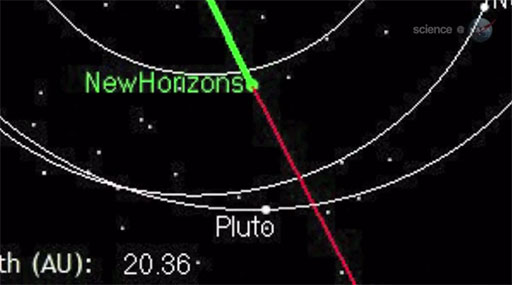1.10 New Horizons Pluto–Charon flyby
In July 2015 the New Horizons mission flew close past Pluto and Charon – its destination after almost a decade in flight. New Horizons explored the Pluto–Charon system and provided more detail than ever seen before, though it did not find any new moons.
When it was at Pluto, the radio signal that it used to send its data back to Earth took about 4.5 hours to reach us, travelling at the speed of light. New Horizons passed close to Jupiter en route, sending back pictures of Io’s erupting volcanoes.
This NASA video was released in 2011, before Pluto’s 4th and 5th moons, now named Nix and Hydra, had been discovered. When the narrator says that New Horizons ‘still has four more years of travel to go’, he is of course out of date. Also, New Horizons did not stop when it reached Pluto. It flew close past a Kuiper Belt object, then known as 2014 MU69 (but subsequently named Arrokoth) on 1 January 2019. Observations of this passing in front of a star [Tip: hold Ctrl and click a link to open it in a new tab. (Hide tip)] as observed from Patagonia in July 2017 suggested that it either has an elongated/dumbell shape or else is a double object (a primary and a nearby moon!) were vindicated when the close up images by New Horizons revealed it to indeed be a contact binary - so no moon to add to the list!

Transcript
See also:
- Charon seen by New Horizons. A bonus video in which David Rothery talks to John Spencer of the New Horizons team. Recorded March 2016.
- Thiolins to not simply walk into Morlok Macula. A likely explanation for Charon’s dark north polar region (Mordor Macula) based on analysis of New Horizons data.
